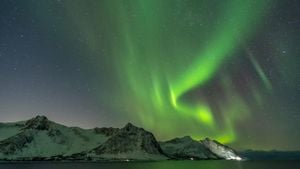On August 12 and 13, 2024, skywatchers around the world were treated to one of nature’s grand displays: the Perseid meteor shower. Known for its spectacular shooting stars, this event reached its peak during these two nights, creating excitement among astronomy enthusiasts and casual observers alike.
The Perseid shower is notorious for producing up to 100 meteors per hour at its peak, as Earth passes through the debris trail left behind by Comet Swift-Tuttle. This comet, which completes its orbit around the sun every 133 years, spreads tiny particles throughout its path, which then burn up upon entering our atmosphere, resulting in bright streaks across the sky.
This year, the meteor shower coincided with favorable conditions for viewing, as experts pointed out the importance of dark, clear skies. For the best experience, observers were encouraged to venture away from city lights, ideally finding locations where they had unobstructed views of the night sky.
According to Jess Lee, an astronomy education officer at the Royal Observatory Greenwich, the best time to observe the meteors would be from midnight to dawn, particularly between 11:30 p.m. and 5:30 a.m. "If we’re lucky, this shower is known for particularly bright meteors," she said, adding, "the current phase of the moon means skies should be dark enough to see many of the shooting stars. "
The excitement surrounding the Perseids was heightened this year by reports of unusual celestial activity. A G4-scale geomagnetic storm struck Earth on the peak night, according to the NOAA’s Space Weather Prediction Center, which led to vivid displays of the aurora borealis across various locations.
Social media was abuzz with images and videos of the meteoric display, showcasing vibrant colors and spectacular celestial fireworks. Observers from places like Ohio captured stunning shots of both the Perseids and the auroras lighting up the night sky.
Noteworthy footage emerged from Delton, Michigan, where the Northern Lights danced above, all within the context of the meteor shower. These simultaneous displays acted as nature’s dual show, thrilling stargazers eager to witness the cosmic event.
Across Europe, many took to open fields and observatories to gaze upwards. Online content about the event, featuring breathtaking photographs and digital renditions, quickly spread, garnering more interest and excitement from those who missed the live spectacle.
The Perseids have long been seen as one of the best meteor shows of the year, but it also has its roots steeped deep within history. The shower has been observed for thousands of years, traced back to ancient cultures who perceived these meteors as celestial omens.
For astrophotographers like Josh Dury from Wales, capturing the Perseids was personal. "Seeing meteors conjures images of dreams, and it is the mysticism I wanted to portray through this image," he reflected on capturing his stunning shot over the iconic Stonehenge.
Such events serve not only to delight those gazing upwards but also play significant educational roles. Astronomers urge the public to engage with these phenomena as they can lead to increased interest and participation in science and astronomy.
Despite the meteor shower’s fleeting nature, astronomers like Daniel Brown from Nottingham Trent University pointed out the possibility of additional peaks. He noted historical instances when meteor activity spiked after the main event, adding, "A meteor shower is not just one evening but can have varying activity over days."
Indeed, the opportunity to witness more meteors was high, with the potential for leftover debris to light up the sky even after the main event had ended. To make the most of this unique spectacle, experts reaffirm the age-old advice: find dark skies and be patient.
Photographers and skywatchers alike were optimistic, armed with cameras and blankets, ready to enjoy the celestial phenomenon. August's warm nights provided the perfect backdrop for this experience, allowing viewers to recline comfortably and soak up the show.
For many, the Perseid meteor shower was not just about watching shooting stars; it was also about the collective experience of marveling at the cosmos and pondering our place within it. The tranquility found under the stars often inspires reflection and connection, both with others and the universe as a whole.
The buzz surrounding the event continues to ripple through social media, with countless spectators sharing their experiences and images of the cosmic show. The engagement shows just how much people cherish these natural wonders and how they bridge the gap between science and everyday life.
With excitement for the Perseids now behind us, astronomy enthusiasts eagerly await next year’s astronomical events, grateful for the moments they can share under the stars. Whether it's the vibrant meteors of the Perseids or future celestial occurrences, the sky always offers new adventures and stories for those willing to look up and enjoy the splendor above.
Looking forward, it’s worthwhile to keep your eyes on the skies. You never know when the next cosmic spectacle will grace the night, reminding us of the beauty and mystery stargazing brings to our lives.



